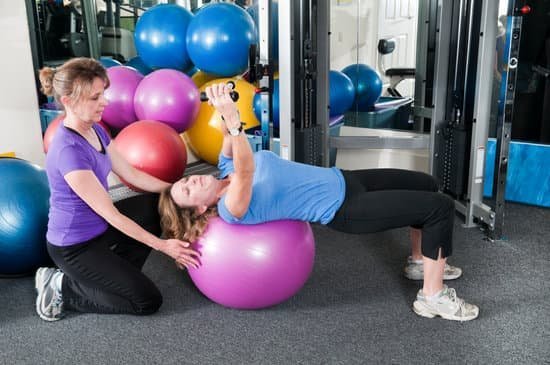Are you wondering how to fit your body with exercise? Understanding the importance of this is the first step towards achieving your fitness goals. Assessing your current body and fitness level, setting realistic fitness goals, finding the right exercise program for your body type, incorporating cardio and strength training, and fueling your body with proper nutrition are all essential in achieving a healthy and fit body through exercise.
Assessing your current body and fitness level is crucial as it helps you understand where you currently stand and what areas you need to work on. Once you have a clear understanding of your starting point, you can then set realistic fitness goals that align with what you want to achieve. Finding the right exercise program for your body type will also be vital as it allows you to tailor your workout to best suit your individual needs.
Incorporating both cardio and strength training into your routine is important for building a balanced workout regimen. Additionally, fueling your body with the proper nutrition will provide optimal performance during exercise. Overcoming challenges and staying motivated and consistent throughout your fitness journey will also play a key role in achieving long-term success. Tracking your progress along the way will allow you to celebrate each achievement as you embrace a healthy and fit body through exercise.
Assessing Your Current Body and Fitness Level
Understanding Your Starting Point
Before embarking on any fitness journey, it’s essential to understand your current body and fitness level. This involves taking a realistic look at your physical condition, including factors such as weight, body fat percentage, muscle strength, and flexibility. It’s also important to consider any existing health issues or injuries that may impact your ability to exercise.
Seeking Professional Guidance
If you are unsure about how to assess your current body and fitness level accurately, seeking the help of a fitness professional or healthcare provider can be beneficial. They can conduct assessments such as body composition analysis, cardiovascular fitness tests, and movement assessments to provide you with a comprehensive understanding of where you stand in terms of physical health and fitness.
Setting Realistic Benchmarks
After assessing your current body and fitness level, it’s important to set realistic benchmarks for improvement. This could include goals such as reducing body fat percentage, increasing muscle mass, improving cardiovascular endurance, or enhancing flexibility. By setting achievable targets based on where you currently stand, you can create a roadmap for how to fit your body with exercise in a way that is personalized and sustainable for the long term.
Setting Realistic Fitness Goals
One of the best ways to set realistic fitness goals is to use the SMART criteria: Specific, Measurable, Achievable, Relevant, and Time-bound. This means that your goals should be clearly defined (specific), quantifiable (measurable), within reach (achievable), meaningful to you (relevant), and have a defined timeline (time-bound). For example, instead of saying “I want to get fit,” a SMART goal would be “I want to lose 10 pounds in 3 months through regular exercise and improved nutrition”.
It’s also essential to focus on both short-term and long-term fitness goals. Short-term goals can help you stay motivated by providing quick wins along the way, while long-term goals can give you a sense of direction and purpose. By setting realistic fitness goals that are tailored to your individual needs and abilities, you can increase your chances of success and ensure that your exercise routine is effective and sustainable.
| SMART Criteria | Example |
|---|---|
| Specific | Lose 10 pounds in 3 months |
| Measurable | Weighing yourself regularly |
| Achievable | Through regular exercise and improved nutrition |
Finding the Right Exercise Program for Your Body Type
When it comes to finding the right exercise program for your body type, it’s important to consider your individual needs and goals. Everyone’s body is different, and what works for one person may not work for another. It’s crucial to tailor your workout to fit your specific body type in order to achieve the best results and avoid injury.
Here are some tips on how to fit your body with exercise by finding the right program for your body type:
- Determine your body type: Before starting any exercise program, it’s important to understand your body type. Are you an ectomorph, mesomorph, or endomorph? Each body type has its own unique characteristics and may respond differently to various types of exercise.
- Research suitable workout routines: Once you’ve identified your body type, research exercise programs that are best suited for you. For example, if you’re an ectomorph, you may benefit from strength training exercises to build muscle mass. If you’re an endomorph, high-intensity interval training (HIIT) may be more effective in burning fat.
- Consult a fitness professional: If you’re unsure about which exercise program is best for your body type, consider consulting a fitness professional. They can assess your unique needs and create a personalized workout plan that aligns with your goals and fits your specific body type.
Overall, the key to fitting your body with exercise is understanding that one size does not fit all when it comes to fitness. By identifying your body type and selecting a tailored exercise program, you can maximize the benefits of exercise while minimizing the risk of injury or overtraining. With dedication and commitment, you can achieve a healthy and fit body that is uniquely suited to YOU.
Remember that everyone’s path towards getting healthier will be different so finding something that works well for each individual is paramount; knowing both strengths as well as limitations is particularly helpful because then we are better predisposed at identifying a regimen that entails exercises tailored specifically for our particular needs.
Incorporating Cardio and Strength Training
When it comes to getting fit and healthy, incorporating both cardio and strength training into your exercise routine is essential. These two types of exercise work together to help you build a balanced and strong body. Here’s how to fit my body with exercise by incorporating both cardio and strength training:
1. Understanding Cardio Exercise: Cardiovascular or aerobic exercise helps improve your heart health, increase endurance, and burn calories. Examples of cardio exercises include running, swimming, cycling, and dancing. It’s important to find a form of cardio that you enjoy so that you can stay consistent with it.
2. Incorporating Strength Training: Strength training involves working with resistance to build muscle strength, power, and endurance. This can be done through weight lifting, resistance band exercises, or bodyweight exercises like push-ups and squats. It’s important to work different muscle groups on different days to avoid overtraining and allow time for recovery.
3. Building a Balanced Routine: To fit your body with exercise effectively, aim to incorporate both cardio and strength training into your weekly workout schedule. A balanced routine could involve doing cardio 3-5 times a week and strength training 2-3 times a week.
By combining these two types of exercise, you can achieve a well-rounded fitness routine that improves your overall health and helps you reach your fitness goals.
Remember that everyone’s body is different, so it’s important to listen to your body and adjust your workout routine as needed. By finding the right balance of cardio and strength training for your unique body type, you can work towards achieving a healthy and fit physique while also improving your overall well-being.
Nutrition and Exercise
When it comes to fitting your body with exercise, nutrition plays a crucial role in fueling your body for optimal performance. What you eat and drink can greatly impact your energy levels, recovery time, and overall fitness progress. Therefore, understanding the importance of nutrition and how it supports your exercise routine is essential in achieving your fitness goals.
The Role of Nutrition in Exercise
Nutrition not only provides the necessary fuel for physical activity but also aids in muscle repair and recovery. Carbohydrates are the body’s primary source of energy, making them essential for fueling high-intensity workouts. Proteins are crucial for muscle repair and growth, while fats provide long-lasting energy during endurance exercises. Additionally, vitamins and minerals play a key role in various bodily functions that directly impact exercise performance.
Eating for Exercise
To fuel your body for optimal performance, it’s important to consume a balanced diet that includes a variety of whole foods. Incorporating lean proteins, complex carbohydrates, healthy fats, fruits, and vegetables into your meals will provide the nutrients necessary to support your exercise regimen. Timing your meals and snacks around your workouts can also optimize energy levels and recovery.
Hydration and Exercise
Proper hydration is just as important as nutrition when it comes to supporting your exercise routine. Water is essential for maintaining bodily functions, regulating body temperature, and transporting nutrients to cells. Staying hydrated before, during, and after exercise can help prevent fatigue, cramping, and dehydration.
By paying attention to how nutrition fuels your exercise performance, you can effectively fit your body with the right combination of food and physical activity to achieve optimal results. Understanding the role of nutrition in supporting exercise is an important step in embracing a healthy and fit body through fitness.
Overcoming Challenges
Staying motivated and consistent with your exercise routine is crucial to fitting your body with exercise. One of the best ways to overcome challenges and maintain motivation is by finding an exercise program that you enjoy. Whether it’s dancing, hiking, swimming, or participating in team sports, choosing a form of exercise that you look forward to can make a significant difference in staying committed.
Another important aspect of staying motivated is setting realistic fitness goals and tracking your progress. By establishing achievable milestones, you can measure your success and stay focused on your journey toward a healthier and fitter body. Keeping a workout journal or using fitness tracking apps can help you monitor your improvements, providing the motivation to continue exercising regularly.
In addition to finding enjoyment in your workouts and setting achievable goals, having a support system can also help you stay motivated. Whether it’s joining a fitness class, enlisting the help of a personal trainer, or working out with friends or family members, having others to encourage and support you can make a significant difference in maintaining consistency.
Ultimately, overcoming challenges and staying motivated comes down to finding what works best for you and creating an environment that fosters dedication to fitting your body with exercise.
| Aspect | Recommendation |
|---|---|
| Finding Enjoyment in Exercise | Choose a form of exercise that you enjoy such as dancing, hiking, swimming, or team sports. |
| Setting Realistic Fitness Goals | Establish achievable milestones and track your progress using workout journals or fitness tracking apps. |
| Building A Support System | Joining fitness classes, hiring a personal trainer, or working out with friends/family can provide the necessary encouragement and support for maintaining consistency. |
Tracking Your Progress
Tracking your progress is an essential part of any fitness journey. Not only does it help keep you motivated, but it also allows you to celebrate your achievements along the way. There are various methods to track your progress, including keeping a workout journal, taking regular measurements of your body, and using technology such as fitness apps or wearable devices.
One effective way to track your progress is by keeping a workout journal. By recording the exercises you do, the number of sets and reps, and how much weight you lift, you can easily see improvements over time. Additionally, noting how you feel during and after each workout can also provide valuable insights into your overall progress.
Taking regular measurements of your body is another important tool for tracking your progress. This includes measuring your waist circumference, hips, chest, arms, and thighs. As you continue with your exercise routine and make healthier choices in terms of nutrition, you may start to notice changes in these measurements. Celebrate every inch lost or every inch gained in muscle – it’s all part of the progress towards a fitter body.
Using technology like fitness apps or wearable devices can also help in tracking progress. Many apps allow you to log your workouts, monitor your food intake, and track various health metrics. Wearable devices such as fitness trackers can provide real-time data on steps taken, calories burned, heart rate, and even sleep patterns. These tools not only make tracking progress more convenient but also provide valuable data that can help fine-tune how to fit my body with exercise effectively.
Conclusion
In conclusion, achieving a healthy and fit body through exercise is a journey that requires commitment, dedication, and a willingness to adapt. By understanding the importance of fitting your body with exercise and assessing your current fitness level, you can set realistic goals and find the right exercise program that suits your body type. Remember, it’s not just about physical appearance, but also about improving overall health and well-being.
Finding the right balance between cardio and strength training, along with proper nutrition, is crucial in fueling your body for optimal performance. Overcoming challenges such as lack of motivation or time constraints is part of the process, but staying consistent will lead to long-term success. Tracking your progress along the way allows you to celebrate your achievements and stay motivated towards reaching new milestones.
It’s important to remember that everyone’s fitness journey is unique, so finding what works best for you may take some trial and error. Ultimately, embracing a healthy and fit body through exercise is not only about the end result but also about the positive impact it has on your overall quality of life.
So keep pushing yourself, stay focused on your goals, and never underestimate the power of how to fit my body with exercise in transforming both your body and mind.
Frequently Asked Questions
How Can I Shape My Body With Exercise?
You can shape your body with exercise by incorporating a mix of cardiovascular workouts, strength training, and flexibility exercises. Cardio helps burn fat, strength training builds muscles, and flexibility exercises improve range of motion.
Which Exercise Make Your Body Fit?
Various exercises can make your body fit, including running, cycling, swimming, weight lifting, yoga, Pilates, and HIIT workouts. It’s important to find activities that you enjoy and that challenge your body in different ways.
How Do I Know What Exercise Is Right for My Body?
The right exercise for your body depends on your fitness goals, current fitness level, any existing health conditions or injuries, and personal preferences. It’s important to consult with a fitness professional to create a tailored workout plan that suits your individual needs.

Passionate about providing useful information to anyone with an interest in the field of Personal Training, I strive to pass on to our readers quality information and to answer any questions about Personal Trainers, the work they do and how to become one.





